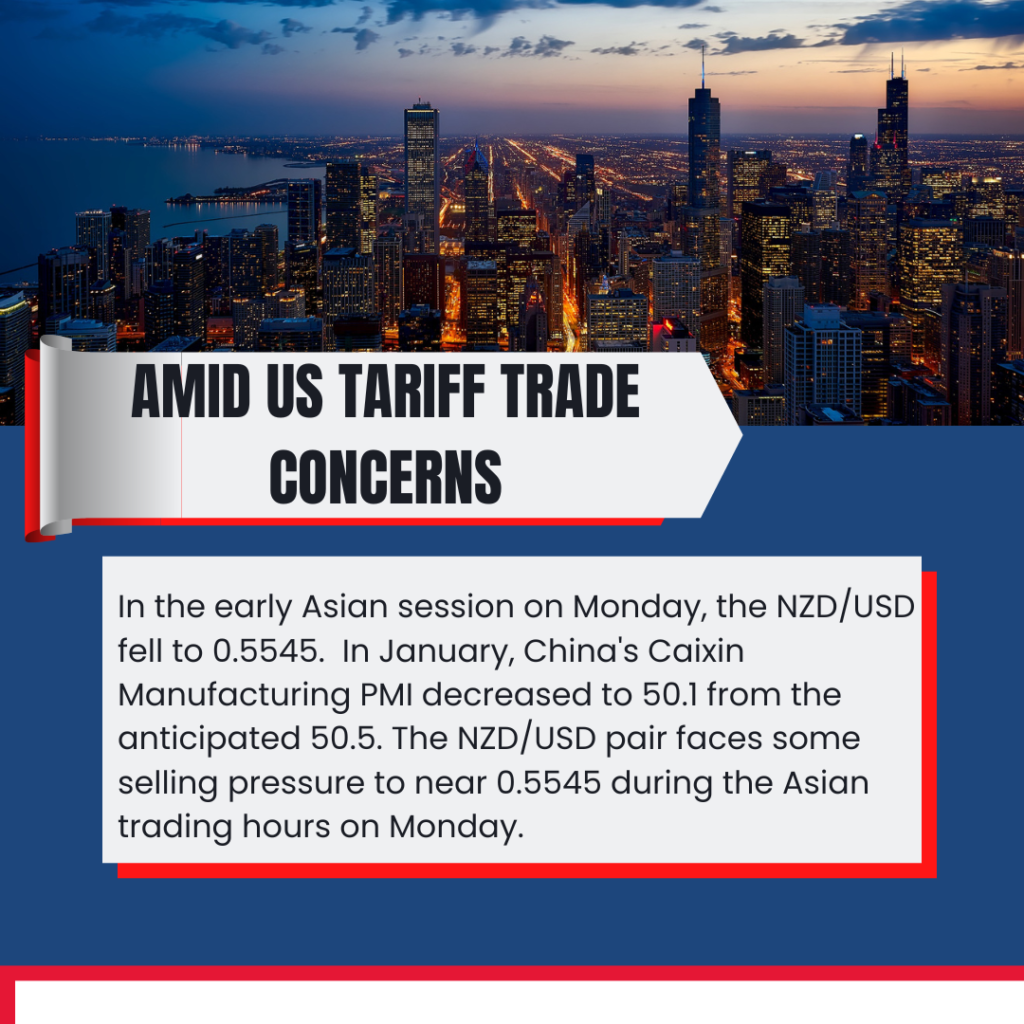NZD/USD Drops to 0.5545 in the Early Asian Session
- In the early Asian session on Monday, the NZD/USD fell to 0.5545.
- In January, China’s Caixin Manufacturing PMI decreased to 50.1 from the anticipated 50.5.
- The USD is boosted as the pair faces a headwind due to concerns over a worsening trade war.
Monday’s Asian trading hours will see some selling pressure on the NZD/USD pair, pushing it to about 0.5545. Following US President Donald Trump’s announcement of tariffs and China’s Caixin Manufacturing PMI coming in lower than anticipated in January, the New Zealand Dollar (NZD) depreciates as trade tensions increase.
Trump imposed tariffs on China, Canada, and Mexico that are set to go into force on Tuesday. China declared it would contest Trump’s tariffs at the World Trade Organization (WTO), and the nations swiftly pledged retaliation actions. The pair is hampered by the risk-off attitude and worries about the trade war, which increase safe-haven flows.
According to data issued on Monday by S&P Global and Caixin Insight Group, China’s Manufacturing Purchasing Managers Index (PMI) decreased to 50.1 in January. Compared to a prior measurement of 50.5, this number was lower than anticipated. Given that China is a significant trading partner of New Zealand, the Kiwi’s immediate response to the negative Chinese economic statistics is still weak.
The New Zealand Dollar (NZD) may be further impacted by the possibility of additional rate cuts from the Reserve Bank of New Zealand (RBNZ). “In line with RBNZ guidance, markets continue to imply another 50bps rate cut to 3.75% at the February 19 meeting and the policy rate to bottom at 3.00% over the next 12 months,” according to analysts at BBH FX.
Which major factors influence the value of the New Zealand dollar?
One of the most popular currencies among investors is the New Zealand Dollar (NZD), sometimes referred to as the Kiwi. The state of the New Zealand economy and central bank policy have a major influence on its value. However, there are a few special characteristics that can also cause NZD to shift. Since China is New Zealand’s largest trading partner, the Kiwi is often influenced by the state of the Chinese economy. Reduced exports from New Zealand to China are probably bad news for the Chinese economy, which will affect the economy and, consequently, the value of the New Zealand dollar. Since the dairy industry is New Zealand’s largest export, dairy prices are another factor influencing the NZD. Increased export revenue from high dairy prices benefits the economy and consequently, the NZD.
How do decisions of the RBNZ impact the New Zealand Dollar?
Over the medium term, the Reserve Bank of New Zealand (RBNZ) wants to reach and sustain an inflation rate of 1% to 3%, with an emphasis on keeping it close to the 2% midpoint. The bank sets interest rates at a suitable level in order to achieve this. The RBNZ will raise interest rates to cool the economy when inflation gets out of control, but this will also raise bond yields, which will make it more attractive for investors to invest in the nation and strengthen the NZD. Conversely, lower interest rates tend to make the NZD weaker. Another important factor in shifting the market is the so-called rate differential, or how rates in New Zealand are or are anticipated to be compared to those set by the US Federal Reserve.
How does economic data influence the value of the New Zealand Dollar?
The New Zealand Dollar’s (NZD) value can be affected by macroeconomic data releases, which are essential for evaluating the country’s economic situation. NZD benefits from a robust economy that is characterized by rapid economic growth, low unemployment, and high confidence. For prop firm tech, this is important since traders who utilize advanced technology and data analytics can predict currency movements and optimize their trading strategies. Prop firms depend on real-time economic data for informed decisions that ensure efficient risk management and maximization of profitability in the forex market.

